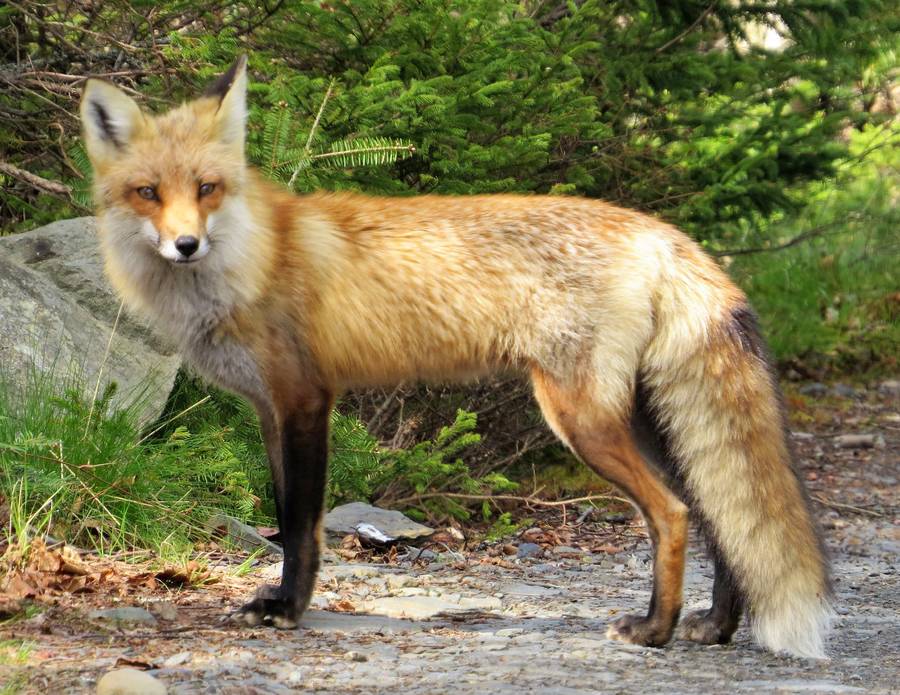
2021-06-30
‘Tis the season for fox and bear sightings
by KEVIN MCBAINLocal Journalism Initiative Reporter
An increasing number of foxes and bears have been maneovering themselves closer to where humans are frequenting and, as a result, people are capturing a greater number of images of them on social media posts.
While some have suggested the increase in animal-human interactions may be due to the controversial clear cutting ongoing amid Nova Scotia's forests, according to Kim Huskins, a forestry and wildlife technician with the Nova Scotia Department of Lands and Forestry in Kentville, it's all "kind of predictable stuff" for this time of year.
She said the populations of the two animals seem to be "steady" and "healthy" across the province.
Foxes are largely a plains animal that enjoy roaming and hunting - mostly rodents - in more open spaces. But they tend to look for well-sheltered habitats near the edges of woods.
"They are one of the interesting critters that I deal with where often they don't become a nuisance unless people impact their behaviour and therefore, make them a nuisance," said Huskins.
She suggested the animals actually are a good species to have around, since they eat mice, rats and other rodents, and keep their populations at bay.
"Most people, once they grasp what the fox is going to be doing, are more than happy to have them around," said Huskins.
There is a fine line, however, such as when the mammals start eating farm animals. In those cases, the landowner might consult with department staff to see what can be done to discourage the unwelcome guest.
Another issue is that often foxes become socialized and are happy to approach people looking for handouts. This happened to birder James Hirtle recently at Bell Island in Lunenburg County.
"It came trotting right up to the car when it saw it. It kept looking at us through the window and kept going around the car looking for a hand out. It finally trotted up the road and went down a long driveway. I drove the car up by the drive entrance and the fox came at a run back up the drive and to the car again. I personally did not give it anything, but fear for this animal in that it is acting so tame," Hirtle, who writes a column on birds for this newspaper, said in an email.
Huskins confirmed some people are known to throw food to coax a fox closer to get a photo. The problem with that, she said, is foxes are highly impressionable.
"What makes it so different from the other species I deal with is they imprint very quickly. What you think is cute, down the road this fox may hop on somebody's deck because it smells a barbecue and they are looking to see if that person has handouts as well," said Huskins. Once fed, the fox may associate people with positive experiences and will continue to look for food from human sources.
"In a lot of cases it starts off quite innocent, and I've even seen photos of people hand-feeding a fox," said Huskins. "Outright attacks are rare, but it wouldn't be that far-fetched to think that the animal could associate your hand with food. If your finger looks and smells like a hot dog?"
Bear sightings in Queens and Lunenburg Counties are equally predictable this time of year, but may have more dramatic consequences, according to Huskins.
Trails at Keji Seaside Adjunct had to be shut down in 2019 because of a bear sighting, and most recently one was spotted in a yard in Green Bay, Lunenburg County.
Bears live deep in the woods and mostly keep to themselves, however, between the time they come out of their dens until berry trees begin producing fruit there is a three-to-four week time period that they will begin to wander and search for food. It's then when bears might be spotted in residential areas.
"There's just not a lot of natural food sources during that time, and when bears come out of their dens they are very emaciated and they need to very quickly put on some weight," said Huskins.
Green bins, recyclables that may not be completely cleaned, bird feeders and even grease from a barbecue can attract bears when they are hungry.
Bears are also very territorial. Sows have cubs every two years and, around the year-and-a-half mark when she's getting ready to have her next cub, the other cub is no longer welcome. This is when the younger bears have to head out and seek food and find their own territory. The best way to avoid having bears in your area is to keep things cleaned up, reminds Huskins.
"If there is no reward in your yard, the bear will find it pointless and they won't expend that energy to get there."
She suggested not using an outdoor green bin, or putting it inside a building or even freezing the contents and putting the material out just prior to pick up.
Huskins is hopeful that both species will continue to be strong in numbers, but in order to achieve that it's important there is minimal contact with people.
"Neither of these species benefit from being close to us humans," she said.








